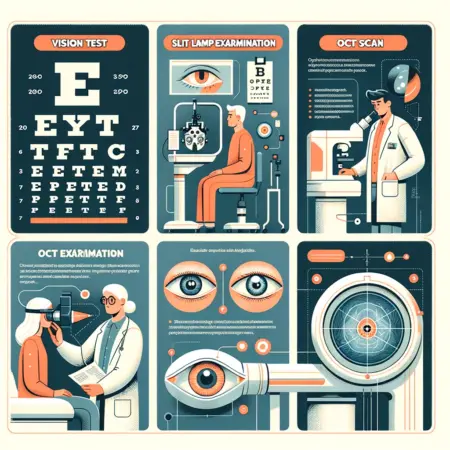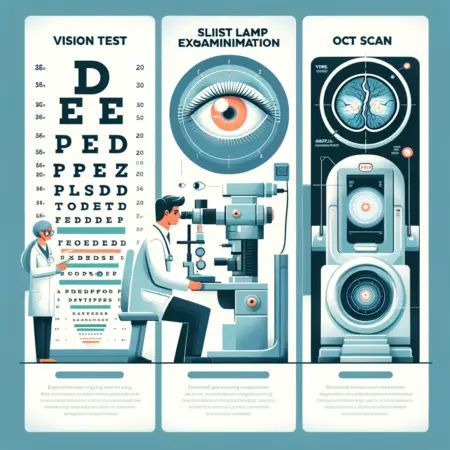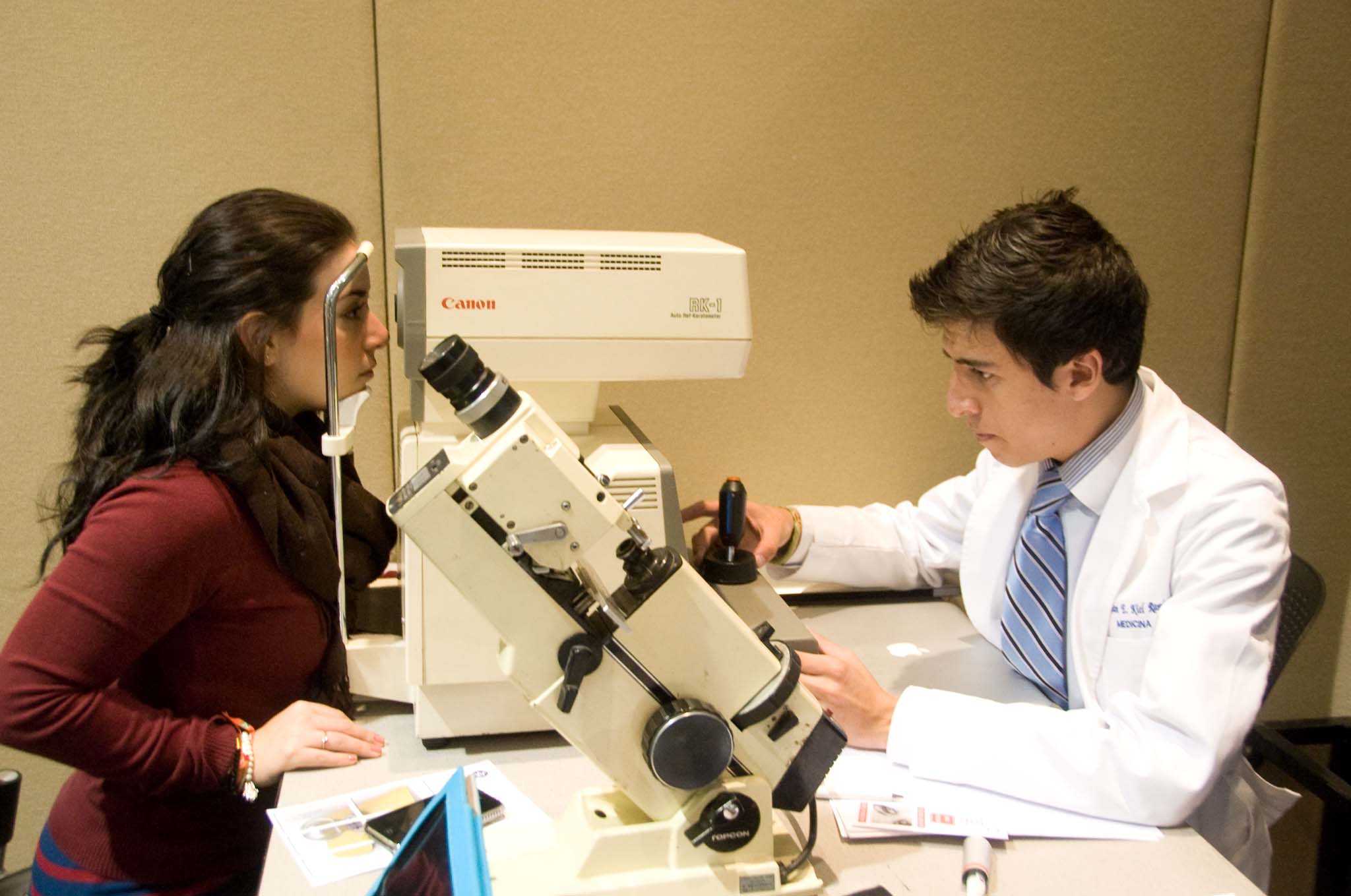How to test the eye diseases.To assess a patient with eye disease, it is necessary to take the patient’s history, the vision and examine the eye. There is usually no need for special locations, such as X-rays and blood tests.you must read my previous article about anatomy of eye.
- History taking is usually fairly simple. The aim is to discover exactly what the patient’s complaints are.
- Testing the vision is also fairly simple, except in young children.
- Examining the eye is the most important part of the assessment. It is also the most difficult.

History taking
It often helps to find out some background information about the patient e.g. sex, occupation and literacy. Such information will indicate what vision the nt needs for work and for personal satisfaction. It will also show if there is a :: any particular environmental or occupational eye disease. The patient’s drinking and smoking habits are also sometimes relevant, i Is important to ask about previous treatment. In many areas where there are enough doctors, the patient may have gone to a traditional healer, bought some medicine from the market, or used another person’s medicine
Complications from such ‘treatment’ are quite frequent. It is true that traditional healers can give useful treatment for certain diseases. However, the eye is such a soft organ that any interference is at best useless, and at worst very harmful, fee family history may also be important. Many eye diseases run in families, such as myopia and glaucoma. Members of the same family also share a common environment.
Hers are obviously many possible symptoms of eye disease, but they usually under one of two headings: loss or alteration of vision, and discomfort or in the eye.
Loss of alteration of vision
Loss of vision is the most common visual symptom. Ask the patient if the onset was sudden or gradual, if there was any pain at first, and if there is any pain now. Visual loss is usually very obvious to the patient. However, the patient may not be aware of a gradual loss of vision in one eye only, or gradual constriction of the visual field.
Complete Guide About How To Test The Eye Diseases For Doctors.
Various alterations of vision may occur:
- Dazzling, or difficulty seeing in bright light may be caused by opacities in cornea or lens.
- Visual field defects may be caused by various disorders in the nerve or visual pathways.
- Photophobia is discomfort caused by bright light. It is usually inflammatory eye disease, especially a corneal ulcer.
- Distortion of shapes usually indicates a disturbance of the retina macular.
- Haloes, or rainbow-coloured rings around lights are caused either by early opacities in the lens, or by corneal oedema. Very small drops of fluid cornea split white light into the colours of the spectrum. Corneal oedema usually indicates a rise in intraocular pressure.
- Spots which ‘float’ in front of the eyes (floaters) are usually opacities in the vitreous body, which cast a shadow on the retina.
Discomfort or pain in the eye
This is usually a symptom of inflammation of the eye, or of the surrounding the eye, or of the structures surrounding the eye.
- The conjunctiva is not very sensitive to pain. Typically, conjunctivitis with discomfort, irritation or prettiness rather than pain.
- The iris and cornea are both very sensitive to pain. Iris, corneal acute glaucoma are three common eye conditions which are characterized moderate or severe pain.
- Inflammation of the choroid (thyroiditis) or optic nerve optic neuritis usually produces a sensation of dull pain behind the eye.
‘Eye strain’ and tiredness of the eyes are common complaints. Sometimes the intraocular muscles of both eyes are not equally balanced, and , strain. However, it is more likely that the cause is psychological rather organic, and means that the patient cannot cope with the stresses of everyday life. Eye strain is very common among students who are having difficult studies. (Many people think that eye strain is caused by refractive errors the patient needs spectacles. However, refractive errors usually cause the vision rather than any specific discomfort or pain.)
Other symptoms
- Discharge, or watering of the eyes is common. It usually indicates conjunctivitis, or an obstruction in the lacrimal passages.
- Diplopia (double vision) is a feature of many types of squint. It will disappear when one eye is shut. Occasionally both the two images come only. This is usually caused by an opacity in the cornea or ler.5. n the light rays from focusing clearly on the retina.
- A headache is a very common symptom, but it is not usually caused by eye disease. However, diseases such as hypertension and intracranial cause headaches and may also produce eye changes.
Testing The Vision
The human eye is an extremely complex organ, and there are many different ways to test the vision. In practice, however, only three types of test are used:-
- Visual acuity, which tests if the patient can see small objects or letters in good light directly ahead.
- The visual field, which tests the overall area of vision for each eye.
- Colour vision, which tests if the patient can discriminate between different colours.
Visual Acuity
It is important to test the visual acuity in each eye separately, if possible. This is usually measured with showing either letters, or pictures for patients who cannot read. If the vision is very poor, other tests are usually appropriate
Unfortunately the method for recording visual acuity is rather complicated. Near each line on the chart is a small number. This number is the distance (in meters) at a person with normal sight should be able to see that line. For example a normal person can see the top letter at 60 metres, the second line at 36 and so on. The patient stands 6 metres away from the chart, and reads as much as he can.If the patient can only see the top letter of the chart, his vision is 6/60. If he can par m the second line, his vision is 6/36, and so on.
Fraction is the distance between the patient and the chart. The bottom number of the smallest line of letters the patient can read.) A normal sight should reach the line which is marked with a 6. This is 6/6 vision.
If the vision is below 6/60 and the patient cannot even see the should come nearer the chart until he can see it. If he can see it a: 21 vision is 2/60. If he can only see it at 1 metre, his vision is 1/60. of testing people with poor vision is to ask the patient to count fingers.The human finger is about the same size as the top letter on the chart, a” and so counting fingers at 6 metres is about equal to 6/60 vision. Counting fingers distance is therefore the same as 1/60.
If the vision is below 1/60, the patient may still be able to detect:: of a hand in front of his eye. If not, the final test is to shine a light There are therefore 3 more categories: –
- HM — Hand movements can be seen in front of the eye.
- PL — Perception of a light shone into the eye.
- NPL — No perception of light, or total blindness.
If there is perception of light, it is also important to test if the patient identify the direction the light is coming from. This is called projection of light. Good projection usually indicates that the retina and optic nerve are| normally. The defect is probably an opacity in the cornea, lens or vitreous body and is treatable. Poor projection of light indicates retinal or opt:: and is probably untreatable.
It is necessary to retest any patient with defective visual activity through a pinhole. If the visual acuity improves when the through a pinhole, it indicates an error of refraction, which spectacles can usually correct. If there is no improvement, then the loss of vision is from eye diseases.
Creating a complete tabular guide for testing various eye diseases involves compiling a structured format that includes several key columns. Here’s an example of how such a table could be structured:
- Disease Name: This column lists the names of various eye diseases.
- Symptoms: Here, you would describe the common symptoms associated with each disease.
- Diagnostic Tests: This column details the tests or examinations used to diagnose each disease.
- Risk Factors: Lists factors that increase the likelihood of developing each disease.
- Preventative Measures: Offers advice on how to possibly prevent each disease.
- Treatment Options: Describes the available treatments for each condition.
- Prognosis: Provides information on the likely course or outcome of the disease.
Here’s a hypothetical example of how the table might look:

| Disease Name | Symptoms | Diagnostic Tests | Risk Factors | Preventative Measures | Treatment Options | Prognosis |
|---|---|---|---|---|---|---|
| Glaucoma | Blurred vision, eye pain | Tonometry, Ophthalmoscopy | Age, family history | Regular eye exams | Medication, surgery | Varies |
| Cataracts | Cloudy vision, difficulty seeing at night | Eye exam, Slit-lamp examination | Aging, diabetes | Sunglasses, smoking cessation | Surgery | Good with treatment |
| Macular Degeneration | Loss of central vision | Amsler grid, Optical coherence tomography | Smoking, obesity | Healthy diet, exercise | Medications, laser therapy | Progresses with age |
This is just an example to illustrate the format. The actual content should be filled in by a medical professional or from reliable medical sources.
Regular testing for eye diseases is an integral part of maintaining good eye health. By undergoing various eye tests, you can identify potential issues early on and seek appropriate treatment. Visual acuity tests, tonometry, slit lamp examinations, retinal evaluations, and visual field testing are all essential in evaluating your eye health. When interpreting the results, it’s important to understand the terminology used and consult with your eye care professional for further guidance and treatment.
